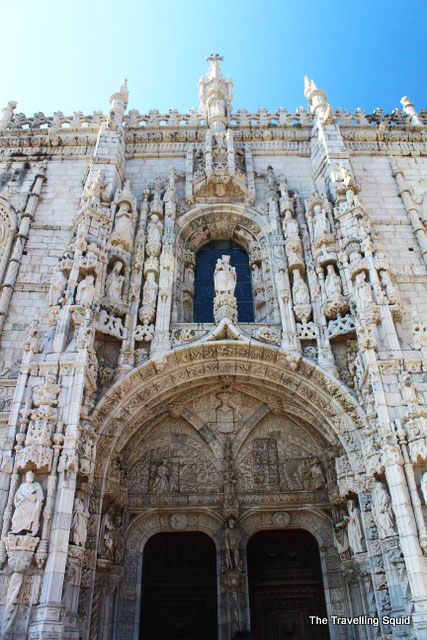Photo Story: Visiting the Jerónimos Monastery in Belem

With its freshly painted white walls and intricately carved statues, the Jerónimos Monastery, despite being the umpteenth cathedral and monastery I had visited in Europe was rather charming. It reminded me of a castle with a fortress, as compared to the Russian Danilov Monastery which we visited in Moscow.

According to Wiki, The Jerónimos Monastery is one of the most prominent examples of the Portuguese Late Gothic Manueline style of architecture in Lisbon. It was classified as a UNESCO World Heritage Site, along with the nearby Tower of Belém, in 1983.
Outer facade




South portal

The ornate side entrance to the monastery was designed by Juan de Castilho and is considered one of the most significant architects of his time. However, the South Portal is not the main entrance to the building. This shrine-like portal is large, 32-metre high and 12-metre wide, extending two stories. Its ornate features includes an abundance of gables and pinnacles, with many carved figures standing under a baldachin in carved niches, around a statue of Henry the Navigator, standing on a pedestal between the two doors.

Axial portal

Although of smaller dimensions than the southern doorway, this is the most important door to the Jerónimos: in terms of its localization in front the main altar and because of its ornamentation. This western portal is a good example of the transition from the Gothic style to Renaissance. It was built by Nicolau Chanterene in 1517. This was probably his first commission in Portugal. It is now spanned by a vestibule, added in the 19th century, that forms a transition between the church and the ambulatory.


Inside the monastery

We were left with no other days to visit the Jerónimos Monastery in Belem, except on Monday, which is a day that it is supposedly closed to the public. Thankfully, a small door was open and we could enter to see grand statues and towers.

The inside walls of the cloister have a wealth of Manueline motives with nautical elements, in addition to European, Moorish and Eastern motifs.

The round arches and the horizontal structure are clearly in line with the Renaissance style, while at the same time there is also a relationship with Spanish architecture. The decorations on the outer walls of the inner courtyard were made in Plateresco style by Castilho: the arcades include traceried arches that give the construction a filigree aspect.


In one of these arcades is the sober tomb of the poet Fernando Pessoa, while several other tombs in the chapter house contain the remains of the poet and playwright Almeida Garrett (1799–1854), the writer-historian Alexandre Herculano (1810–1877), former presidents Teófilo Braga (1843–1924) and Óscar Carmona (1869–1951).



With credits: Wikipedia
The Travelling Squid’s Take
The Jerónimos Monastery in Belem is probably the biggest, most significant monument in Belem. The inner facades of the monastery are definitely worth exploring, therefore try to visit Belem during other days of the week, except Monday. I was pleasantly surprised to find statues of great men lying by the side of stained glass windows with sunlight streaming in. It did seem like an ideal resting place. That was a simple, peaceful moment, unspoilt by the tourists that thronged the great halls. A moment which I had to myself. Just me, myself and I.
* * *
Have you been to the Jerónimos Monastery in Belem?
Please share your thoughts.

Leave a Reply